Technology
Researchers Reveal Virtual Reality May be Bad For You
Published
3 years agoon
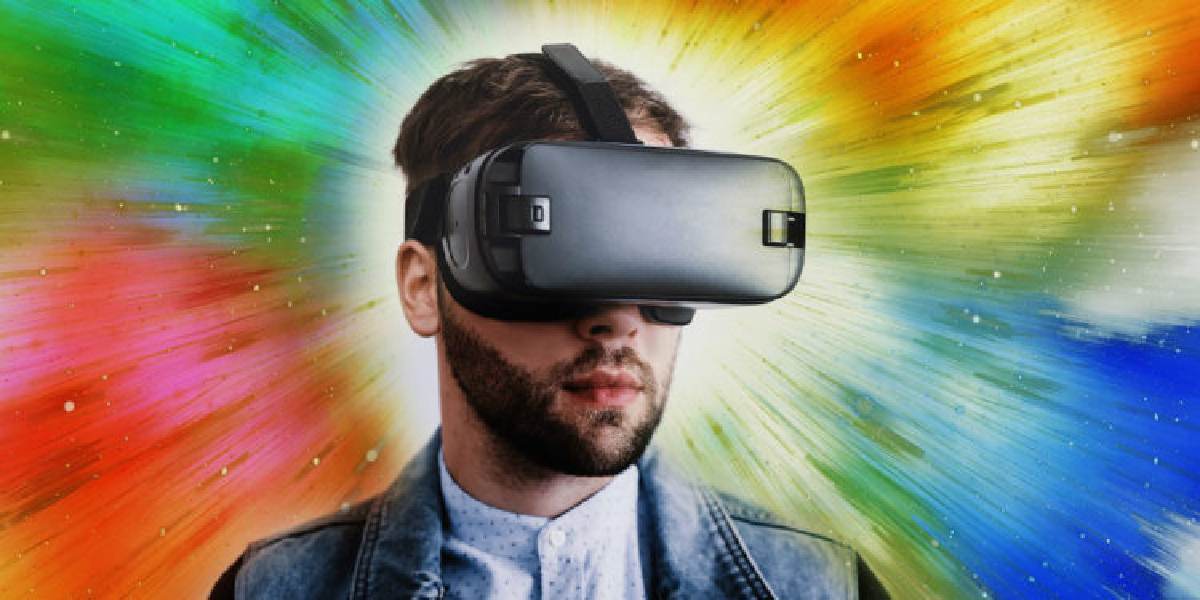
Virtual reality (VR) opened up possibilities to immerse ourselves into different worlds through games or other experiences. Although we are in awe of the imaginary worlds or places we travel to in virtual reality, it poses risks to our sense of reality. A study in Computers in Human Behavior found that virtual reality may be bad for you. Why? Let’s find out below.
How can VR be bad for you?
This might make you wonder, how can VR be bad for you? Niclas Braun and his co-researchers and writers have found some people that may be experiencing depersonalization and derealization after regular use of VR. The researchers have further stated that one session can put you at risk of exhibiting symptoms of depersonalization and derealization. But before we delve into the study itself, let’s learn what depersonalization and derealization are.
Mayo Clinic defines depersonalization (DP) and derealization (DR) as a condition where you might feel things don’t seem real, or you seem out of touch with your body, and you’re observing it from a distance.
Now, back to the study. The researchers noted that while their participants may have had symptoms of DPDR, it’s unclear whether they would have that condition following usage of VR. After all, the researchers had only asked participants to record and report their symptoms post-gaming, one-day post-gaming, and one-week post-gaming. For them to identify the symptoms of DPDR, participants had to answer a personality inventory.
The participants played Elder Scrolls V: Skyrim. This game was chosen because of its immersive nature and device compatibility. In addition, the researchers chose a particular scene in the game where the player would have to escape from a dragon because of its vividness and excitability.
The Results
In their study, while they examined the effect of VR, they also had other participants playing using a personal computer (PC). It allowed them to compare how high the DPDR symptoms were compared to the PC users. The researchers found that participants from both sets (VR and PC) had experienced symptoms relating to DPDR, with VR users experiencing it at a greater scale.
But should gamers worry about the future? No. The researchers have stated that while DPDR symptoms manifested in their participants, they suggest that the immediate DPDR symptoms MAY NOT affect gamers long-term. Plus, they note that future studies can also focus on other games and the longevity of VR usage for more insights on this matter.
One thing to note here is that this wasn’t the first study to tackle how virtual reality may be bad for you. One of the earliest studies was in 2010. It was also referenced in the current Braun et al. article. It was also mentioned that after immediate use of VR, participants had experienced DPDR symptoms.
Other Effects of VR
With VR relying heavily on a headset, prolonged use can also affect your health physically. Headaches and nausea are the two common symptoms of cybersickness. These were also tested in the Braun et al. article. They found that some participants had experienced motion sickness.
Using VR: Best Practices
As enticing as it is to use VR for hours on end, make sure that you’re also taking care of yourself to avoid symptoms of DPDR or cybersickness.
- The Department of Business, Energy, and Industrial Strategy suggests using your VR headset for 15 to 30 minutes only. After that, you should take a 10 to 15-minute break.
- Wired talked to Dr. Adrian Priesol about what to remember when wearing a VR headset. He says that the VR headset should fit properly on your head and the interpupillary distance settings are also adjusted well. And if you need glasses, make sure that it’s comfortable on your headset. Not only that, but you should set the frame rate to 60 frames per second or higher.
- Healthline says you can take Dramamine if you’re feeling nauseous. Plus, you can use other equipment to aid your use of VR, such as VR treadmills and cybershoes.
You may like
Technology
Top 10 Shipping Software Options for Businesses
Published
8 hours agoon
September 5, 2025By
Carmen Day
As a small business owner, shipping logistics and order management can become a hassle. With fluctuating fees based on size and location, keeping track of everything can take a lot of time and effort. That’s why new entrepreneurs should consider purchasing an automated shipping software system.
Getting shipping software is a great way for you to increase efficiency and save time and energy. Instead of doing everything manually or relying on an outside service, you can get your end-to-end shipping needs taken care of without breaking as much of a sweat. In addition, by integrating the service with your site, you can forget about orders once sent out and set it and forget it.
Yet if you’re new to the industry, it may be challenging to navigate your options. That’s why we’re here to provide you with the top 10 best shipping software for e-commerce.
1. Shipstation

Shipstation is an affordable and multi-carrier shipping software that is best for small businesses. Customers can switch between companies to get the best value for their money. In fact, here, people can set an automated feature that selects the cheapest option every time. Shipstation integrates with Amazon, UPS, FedEx, DHL, and USPS. Their shipment rates start at $9.99 per month for 50 shipments.
2. ShipTime
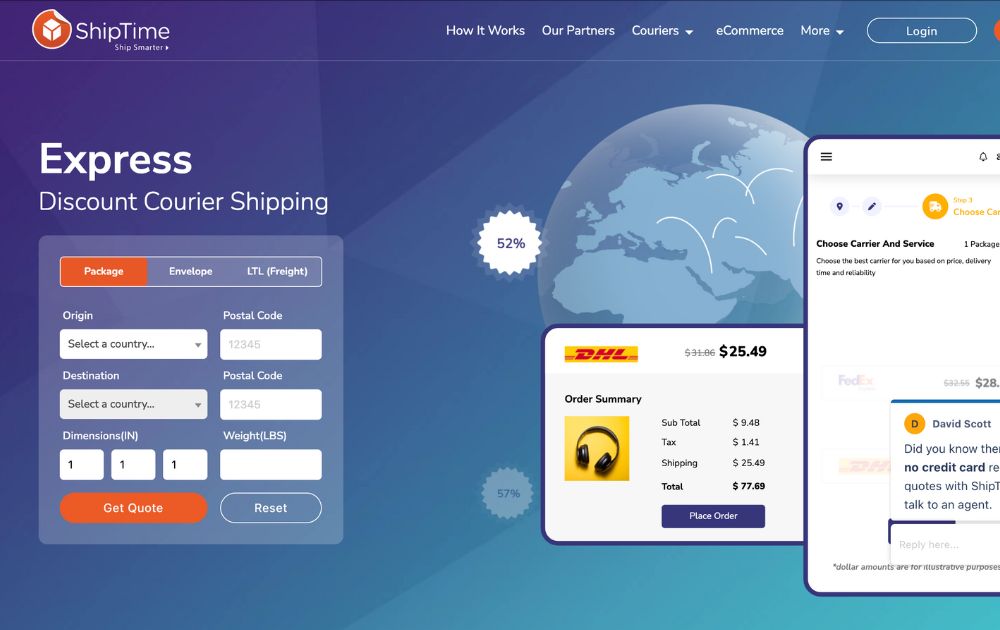
Meanwhile, if you’re looking to ship items that are big and small, ShipTime is well known for its parcel shipping methods. It partners with FedEx, GLS, Canada Post, DHL, and more. The company also provides discounted insurance as well as branded tracking to make sure you receive your packages securely. Finally, Shiptime integrates with popular e-commerce platforms like Shopify, WooCommerce, Etsy, and more.
3. Sendcloud

Just like ShipTime, Sendcloud is great shipping software for small business owners. The company offers after-sales support by providing affordable integrations to many e-commerce sites. Sendcloud also minimizes the fuss around order label printing by filling out the shipping details for you. You don’t need a whole lot of knowledge about shipping, setting up and getting started is incredibly easy here.
4. Freightview

On the other hand, if you are looking for a supply chain management solution, you’d want to know more about Freightview. Their platform allows users to compare rates, track orders, and schedule pickups. However, its best feature is that it creates a bill of landing contracts, and you’ll also be allowed to negotiate rates with your carrier through the platform. Freightview comes at a higher cost than most competitors at $99 a month.
5. ShippingEasy

If you want to prioritize your customers, you can take a look at ShippingEasy and its award-winning customer support. Aside from this, their best edge is that it promotes carbon-neutral shipments at no extra cost—which is an option your buyers might want for themselves. Finally, ShippingEasy has a free package that gives you 25 shipments a month. Meanwhile, their paid plans start at $20 with under 200 shipments a month.
6. Shipsy
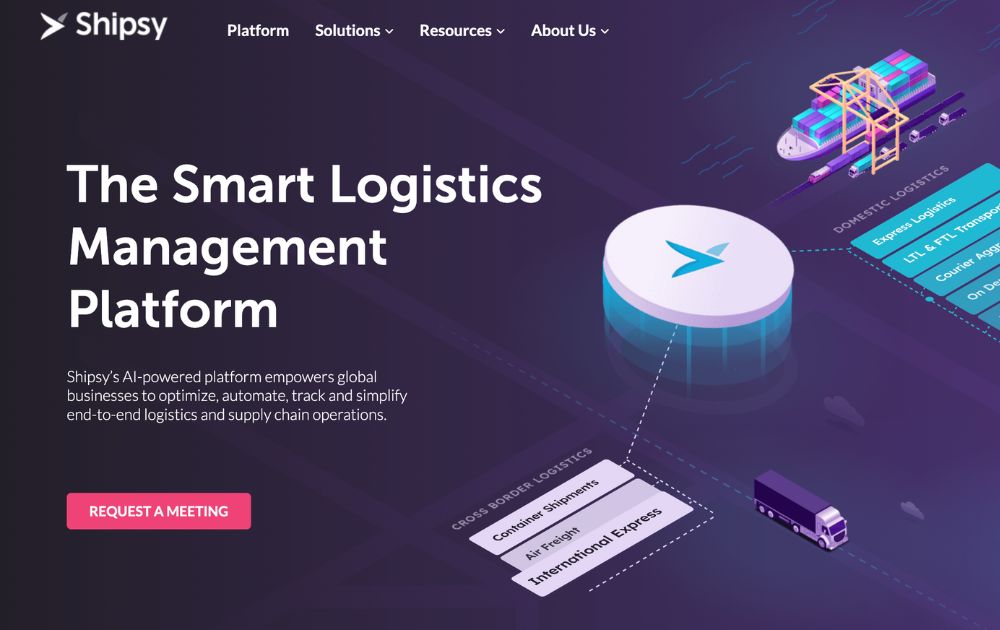
Shipsy is best for brands that ship globally, as their handle end-to-end logistics support using their platform that runs on AI. This company puts a premium on visibility, so you can see the prices of exporters, importers, and third-party logistics providers using their dashboard. Aside from that, you can also get analytics from your shipments and avail live location tracking.
7. EasyPost
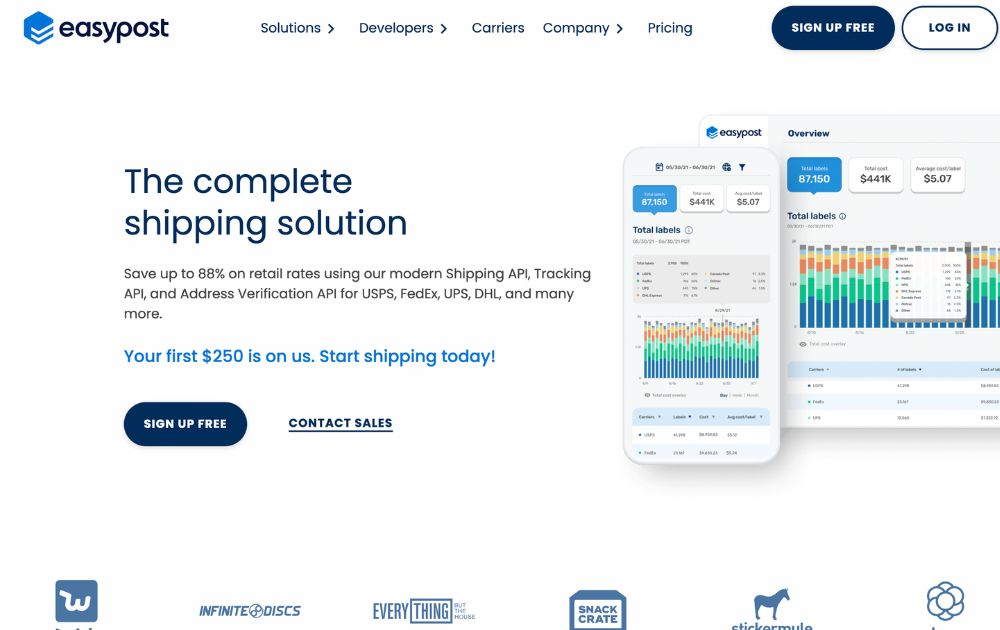
EasyPost is yet another affordable and reliable shipping solution. You can get special discounted rates when you carry with DHL, UPS, USPS, and more. But that’s not all. They also offer over a hundred carriers to fit your needs. Aside from that, they also offer green shipping through their carbon-neutral option. In short, EasyPost also lets you print labels, track packages, and ensure your customers’ shipments are in one place.
8. ShipWorks

ShipWorks, on the other hand, works best for high-volume sellers. If you’re a warehouse or an in-demand e-commerce merchant with multiple locations, you can take advantage of ShipWorks’ huge shipment capacity. Because while most only cover 5,000 shipments a month, ShipWorks handles over 10,000 shipments a month. You can get started with their warehouse essential plan starting at $349 a month with 12,000 shipments.
9. ClickShip

ClickShip isn’t that different as compared to other trusted software. It offers transparent pricing, exclusive shipping discounts, and web integrations for users. However, one standout is its package optimization feature that suggests to its users which packaging works best for a certain shipment. This small add-on may be the solution you’re looking for to save time. Their starter pack costs $9 a month.
10. Shippo
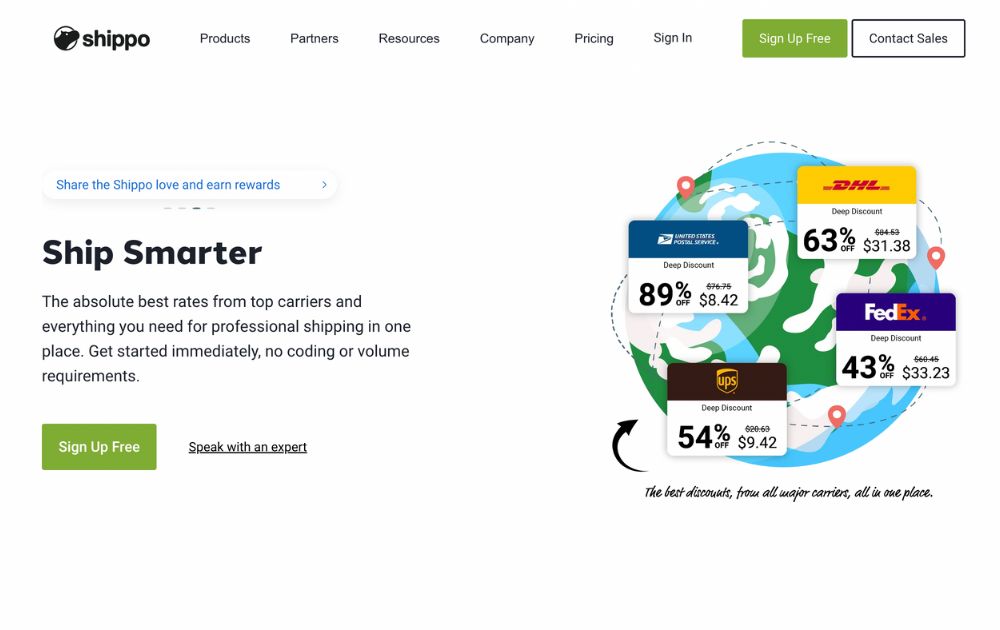
Meanwhile, Shippo is another multi-carrier software that tracks shipments and creates order labels for you. It’s a trusted solution by over 100,000 businesses in the e-commerce sector. Plus, they offer email and live chat support to ensure your customers are getting their shipping problems taken care of. You can get a professional plan at $10 and it comes with carrier discounts.
How to choose the right shipping solution for you
Before making the jump to buy shipping software, you want to make sure that all their services are right for you. After all, there are many types of shipping software companies that provide different services depending on your industry. Just as in choosing a POS system for small business, you need to make sure that you’re selecting one that satisfies your venture’s unique needs.
For instance, small businesses may opt for multi-carrier shipping software to integrate with different carriers. But, if your needs lean toward the global market, you may want to check international shipping software that caters to freight management and forwarding.
Another factor to consider is the company’s customer support. How does the company handle lost parcels or unclaimed items? Your shipping software should make it easy and accessible to buy from your store. Make sure you allot some time to read through their policies and how they solve problems.
Finally, consider how many carrier options you’re offering to your customers. People are looking for the best deals all the time, so be sure to stay updated on the latest industry carriers you can integrate with. Also, be mindful of exclusive prices and sales deals too, as some companies offer shipping software free discounts.
Technology
Top 10 Pet Tech Products That Redefine How We Care for Pets
Published
16 hours agoon
September 5, 2025
Pet parents know the responsibilities that come with caring for their furry children. And that some of them would wish they could understand their fur babies. Pet tech is available on the market to make their lives easier.
But some pet tech that may leave a dent in your wallet, and you’re probably better off with all your current tools in caring for, grooming, or understanding your pets.
Here are the top 10 pet tech ideas that raise eyebrows or make you say, “take my wallet!”
1. Tractive Dog and Cat Collars

Tractive offers health monitoring and GPS for pets. It prides itself on being the top player within its niche, with its device now capable of monitoring a pet’s vital signs. In fact, it can track a dog or a cat’s heart and respiratory rates. It can also send you smart alerts, including update about changes in sleep and activity.
2. Furbo 360° Dog Camera

Furbo 360° Dog Camera allows you to take care of your pet when you’re not at home. This camera and treat dispenser in one offers a full rotating view and treat tossing. It’s a perfect gadget for any one who wants to stay connected with their fur babies at all times.
3. SureFlap Microchip Pet Door Connect

SureFlap Microchip Pet Door, meanwhile, offers an app-controlled microchip door. This device ensures that only your pets get inside your home with the use of your pet’s RFID collar or microchip. To complement the device, this product comes with an app that lets you monitor your pet when they pass through the door and also allows you to lock or unlock the door remotely.
4. Lavviebot S
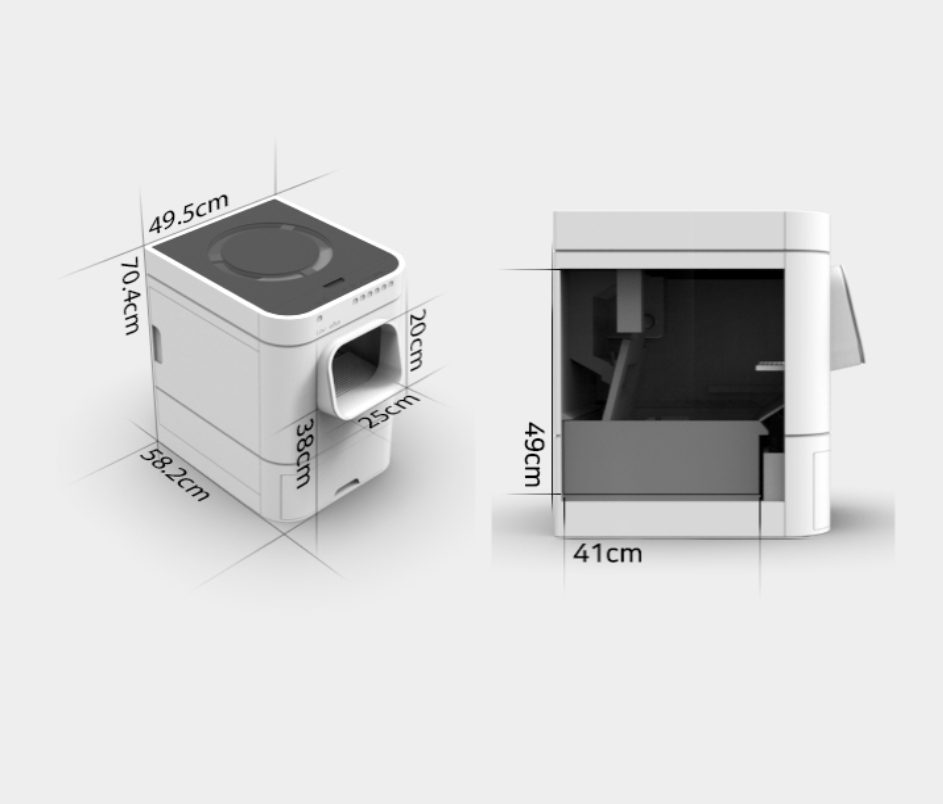
The Lavviebot S made it to this top 10 pet tech list. But this one doesn’t warrant any eyebrow raises, though, and it’s somewhat useful for cat parents. The Lavviebot S will reduce the amount of cleaning you need with an ordinary litter box. Plus, the Lavviebot S will send you an alert when your fur baby has done its business. This one’s not ALL that bad.
5. Petcube Bites
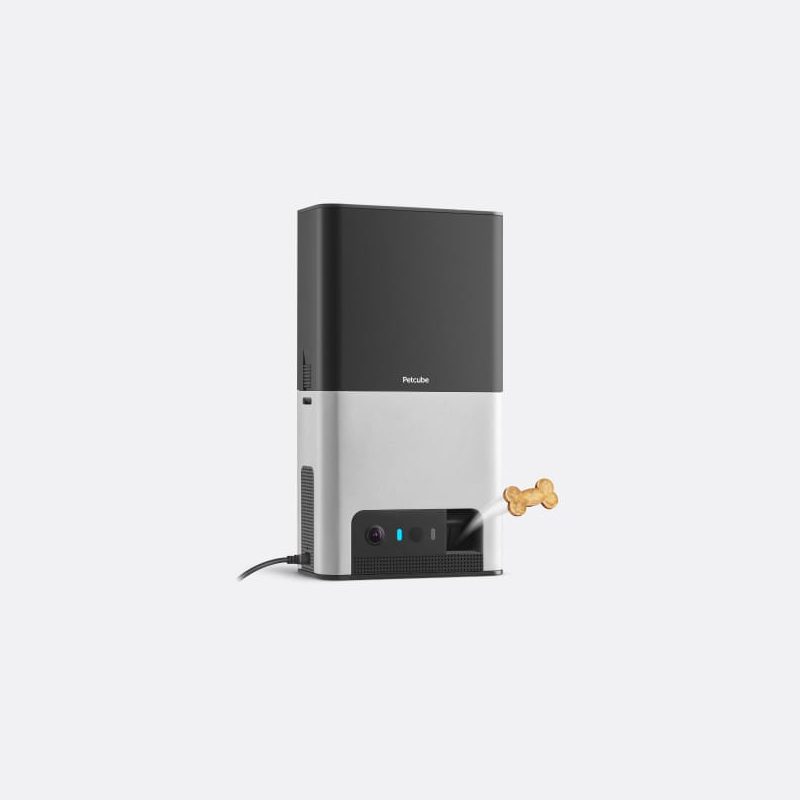
Here’s one cool pet tech you might want to consider buying. The Petcube Bites will help you feed your dog while you’re away. And when you’re not at home, you can even talk to your fur babies through the device. Pretty neat, right?
6. Catit Automatic Cat Drinking Fountain

Hydration tech has grown over the years, with pet owners putting a premium on hydration to help prevent health issues. That said, the Catit Automatic Cat Drinking Fountain helps pet owners track their furbaby’s water intake. It also sends a notification when the water is low, making it a good addition to essentials when adopting a cat.
7. Halo Collar 3

For fur parents who want to provide both freedom and safety, the Halo Collar 3 is a nice gadget to have. This divide creates a virtual fence without physical barriers, allowing the user to track pets’ locations in real time. It also lets pet owners set safe zones and set up training features built into the collar.
8. Puppod Interactive Dog Game
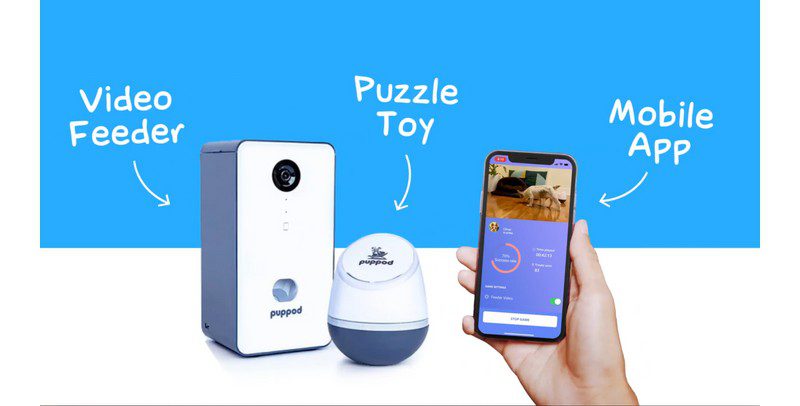
One way to bond with your dog is to play games with them. The Puppod Interactive Dog Game helps you do that. But you might wonder, do you need a device to play with them? Well, this one does have the upper hand over traditional pet games since this could train your dogs. It’s one of the best top 10 tech you might want to consider buying.
9. Treat Launcher
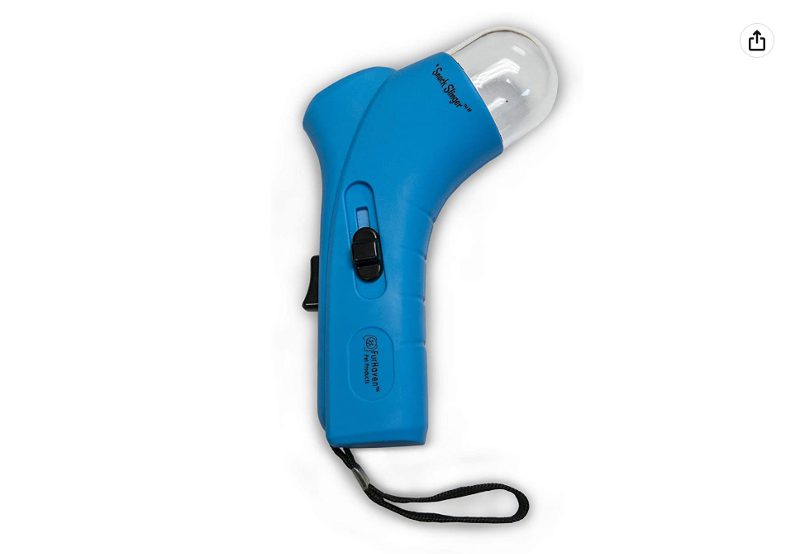
If the Petcube Bites are a hit, the Treat Launcher doesn’t seem like it is. The treat launcher can be a great trick to see how high your dog can fly and catch the treats mid-air. However, Amazon users have reported that there have been issues loading the treats. Well, it’s best to stick with the old-fashioned way of giving treats to your furry buddies: your hands.
10. iFetch
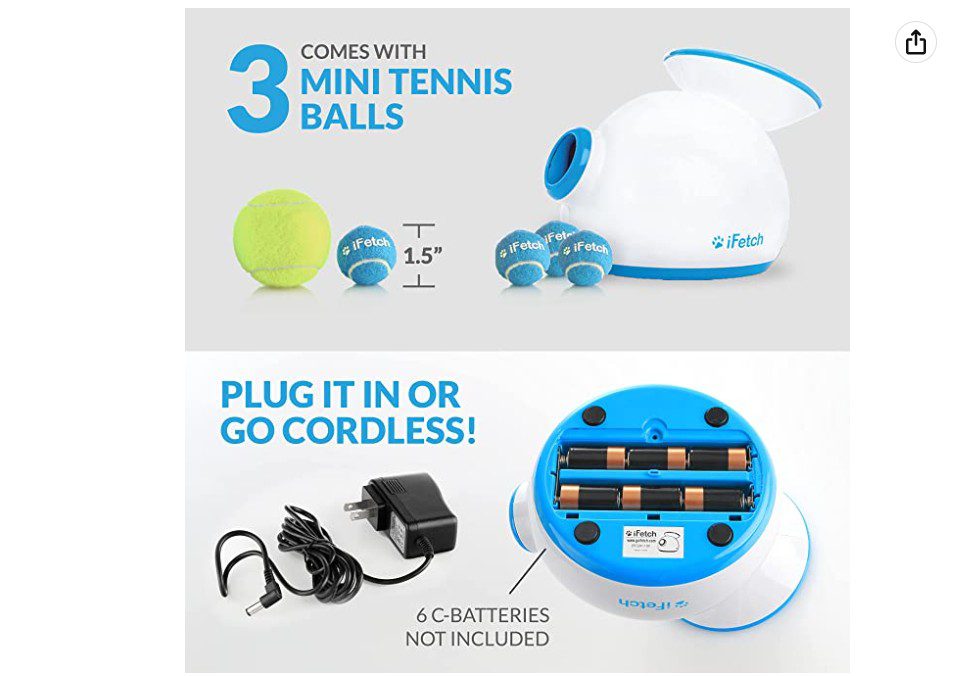
We’re on the fence with this one. Playing fetch with your dogs is one way to bond with them. But the iFetch may take that element out of your day. Sure, you can do other things while your dog or dogs might have fun with the iFetch, but many customers on Amazon have noticed that it only lasted a few months, and it might be dangerous for your fur babies too.
Technology
Top 10 Customer Service Software Tools Every Business Needs Today
Published
16 hours agoon
September 5, 2025
Every established business owner will tell you that one of their secrets to success is providing excellent customer service. This is why there’s an emergence of tools specifically designed to make the process simpler and easier. If you’re looking for one, here is our list of the best customer service software you can consider.
1. Zendesk

Zendesk customer service software enables businesses to establish flawless customer experiences. It allows a seamless flow of communication across channels, resulting in improved productivity and satisfaction of stakeholders.
Key Features:
- Ticket routing
- Live chat software
- Native integrations
- Knowledge base
- Application Programming Interface (API)
- Tracking and reporting
- Self-service portal
- Community forums
- Automation
Pricing:
Support Team: $25 per agent/month
Suite Team: $69 per agent/month
Suite Professional: $149 per agent/month
Suite Enterprise: $219 per agent/month
Free trial: 14 days
2. Sprout Social

Sprout Social is a platform that allows teams to deliver relevant customer support. Its sales, support, marketing, social media monitoring, and engagement features facilitate effective communication across all social networks.
Key Features:
- Reporting and analytics
- Automation
- Tracking and reporting
- Customer segmentation
- Social media monitoring/management
- Post scheduling
Pricing:
Standard: $199/per seat/month
Professional: $299/per seat/month
Advanced: $399/per seat/month
Custom
Free Trial: 30 days
3. Hootsuite

Hootsuite helps teams connect with clients and schedule content in multiple social channels from a secure web-based dashboard. The Zendesk native integration enables Hootsuite to create, review, and update information from various social media channels. In addition, the Hootsuite and Zendesk tandem eliminates the silos between social and support departments.
Key Features:
- Automation
- Tracking and reporting
- Customer segmentation
- Social media monitoring/management
- Post scheduling
Pricing:
Standard: $149 per user/month
Advanced: $399 per user/month
Enterprise: Custom
Free trial: 30 days
4. MailChimp

MailChimp helps businesses to create, send, and track email newsletters, event invitations, and registration forms. Teams can customize the emails with targeted customer segments combined with a customer support system like Zendesk Support. MailChimp can act as an all-in-one marketing platform for small businesses.
Key Features:
- Tracking and reporting
- Contact management
- Landing page and email design tools
- Automation
- Social media monitoring
- Live chat
Pricing:
Free: up to 500 contacts
Essentials: $6.50 per month for 12 months
Standard: $10 per month for 12 months
Premium: $175 per month for 12 months
5. SurveyMonkey

SurveyMonkey is a customer service platform that provides businesses with templates for customer surveys to glean insight into product or feedback and customer satisfaction. With its extensive library of integrations, you can efficiently work this tool into your existing workflow.
Key Features:
- Live results tracking
- Polling
- Tracking and reporting
- Image/audio/video file support
- Email distribution
- Native integrations
- API
Pricing:
Basic: Free
Individual Advantage: $39/month, billed annually
Individual Standard: $99/month, billed annually
Individual Premier Annual: $139/month
Team Advantage: $30 per user/month
Team Premier: $92 per user/month
Team Enterprise: Contact the sales team for a quote
6. Slack
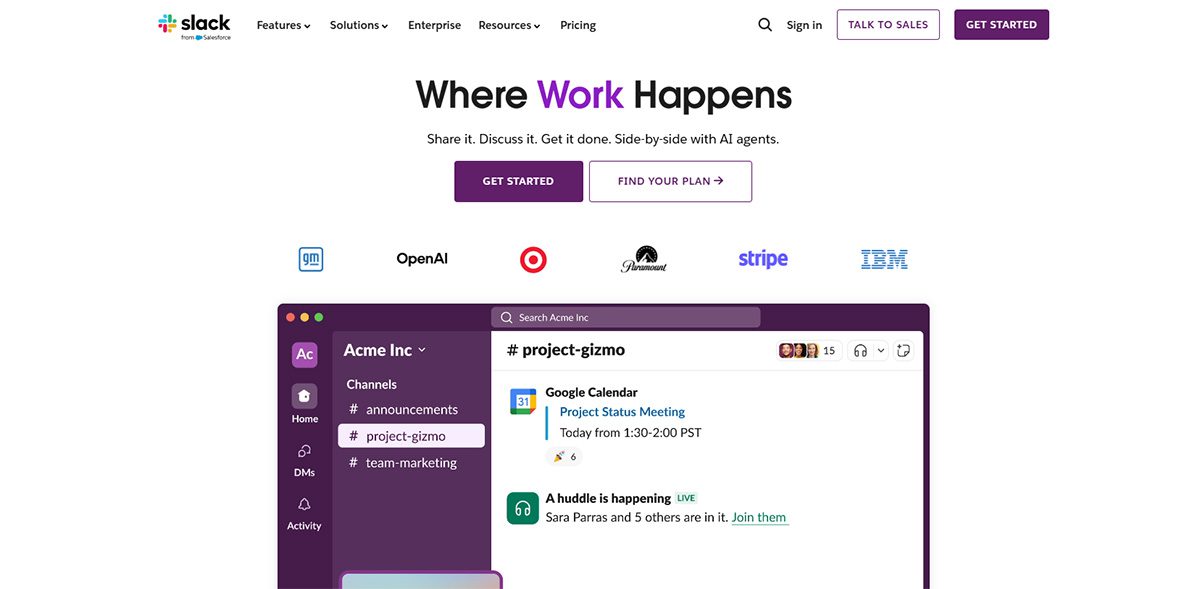
Slack helps internal customers to seek assistance from the HR or IT team from the same communication channel. With Slack’s AI-powered bot, employees can self-serve over Slack at scale. When integrated with customer service software, Slack also enables agents to communicate better with each other when addressing tickets for more streamlined collaboration and faster.
Key Features:
- Live chat
- Video conferencing
- Messaging
- Native integrations
- API
- Community forums
- Surveys
Pricing:
Free plan available
Pro: $8.75 per person/month
Business+: $18 per person/month
Enterprise+: Contact the sales team for a quote
Contact the sales team for a free trial
7. Boss Solution Suite
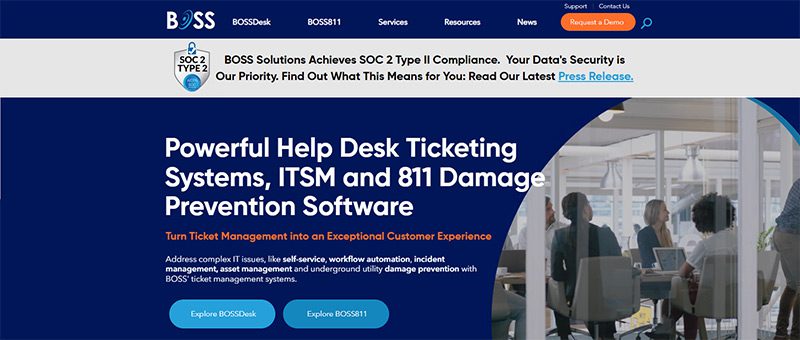
Boss Solutions Suite offers a fully functional ITIL-based help desk software and IT asset management package available on-premise or on the cloud. Their customers include the public, education, and healthcare institutions. Boss Solutions also provides asset, incident, and change management capabilities.
Key Features:
- Ticket routing
- Native integrations
- Knowledge base
- API
- Tracking and reporting
- Self-service portal
- Automation
Pricing:
Contact the sales team for pricing
8. Jira Service Desk

The Jira Service Management software empowers IT teams with a modern service desk. It has everything they need out-of-the-box, including ITIL-certified processes. Atlassian developed Jira to remove silos between developers, operations, and IT. Non-IT customer service professionals may feel that Jira’s features are excessive for their needs. If unsure, try JIRA’s 7-day free trial to give you a feel for the software.
Key Features:
- Ticket routing
- Live chat
- Knowledge base
- API
- Tracking and reporting
- Self-service portal
- Automation
Pricing:
Free plan: free for up to three agents
Standard: $19.04 per agent/month
Premium: $47.82 per agent/month
Enterprise: contact sales for a quote
Free trial: 7 days
9. LiveAgent

LiveAgent is an excellent solution for smaller service teams using WordPress. Its extensive library of native integrations allows your team to seamlessly work it into their existing workflows. Likewise, it has native integration for several popular apps for support teams.
Key Features:
- Ticket routing
- Live chat software
- Native integrations
- Knowledge base
- API
- Tracking and reporting
- Self-service portal
- Community forums
- Automation
Pricing:
Small Business: $9 per agent/month, billed annually
Medium Business: $24 per agent/month, billed annually
Large Business: $39 per user/month, billed annually
Enterprise: $59 per agent/month, , billed annually
10. Freshdesk

Freshdesk helps customer service teams organize collaboration and automation with its interactive interface and competitive pricing packages. Freshdesk offers all the essential features in its more expensive plans, such as team dashboards, social signals, ticket routing, and chatbots.
Key Features:
- Ticket routing
- Live chat software
- Native integrations
- Knowledge base
- API
- Tracking and reporting
- Self-service portal
- Community forums
- Automation
Pricing:
Free Plan: $0 for up to two agents
Growth: $18 per agent/month
Pro: $59 per agent/month
Pro + AI Copilot: $94 per agent/month
Enterprise: $95 per agent/month
Free trial: 14 days
Conclusion
Figuring out what customer service software best serves you and your team can be daunting. It would help if you found a tool that meets your immediate needs and is flexible enough to cover future needs, all while staying within budget. Take your time to weigh your options and make a wise decision. The service you deliver to your customers is crucial regardless of which software you choose.

Top 10 Shipping Software Options for Businesses

Top 10 Pet Tech Products That Redefine How We Care for Pets

Top 10 Customer Service Software Tools Every Business Needs Today

Is This Business an MLM? The Color Street Reviews

What’s the Best Design as a Service? Find Your Match

What’s the Best Creative as a Service? A Guide for Businesses

What’s the Best Design Subscription Service? Here’s What to Know

Top 10 Pet Tech Products That Redefine How We Care for Pets

FN Meka, the world’s first AI rapper, gets booted out by record label

Top 10 VPNs 2022 to Consider

Top 10 Powerful Chatbot Platform Builders for 2025

Is This Business an MLM? The Color Street Reviews

10 Influencer Marketing Tools to Garner More Followers

Top 10 Shipping Software Options for Businesses
Trending
- Technology16 hours ago
Top 10 Pet Tech Products That Redefine How We Care for Pets
- Business1 day ago
Is This Business an MLM? The Color Street Reviews
- Technology8 hours ago
Top 10 Shipping Software Options for Businesses
- Technology16 hours ago
Top 10 Customer Service Software Tools Every Business Needs Today
- Top 105 days ago
What’s the Best Design Subscription Service? Here’s What to Know
- Business3 days ago
What’s the Best Creative as a Service? A Guide for Businesses
- Uncategorized3 days ago
What’s the Best Design as a Service? Find Your Match







